Sexual medicine treatments
Peyronie´s disease
Peyronie's disease occurs as a consequence of any alteration in the symmetry of the corpora cavernosa of the penis.
PEYRONIE'S disease
Table of Contents
DEFINITION
What is Peyronie's Disease?
Peyronie’s disease (shortened to Peyronie’s) is a disorder characterized by the penis bending over somewhere, especially during erection, making intercourse difficult.
The curvature of the penis is a frequent reason for consultation among urologists because it can interfere with satisfactory sexual intercourse and produce anxiety and distress about low sexual performance.
Many other men with Peyronie’s curvature don’t see a doctor because of the embarrassment of recognizing that their sexual potency and performance has diminished.
Info
Peyronie's disease occurs as a result of any alteration in the symmetry of the cavernous bodies of the penis. These bodies are in charge of producing and maintaining erections in the face of appropriate sexual stimuli with the filling of blood.
If either of the two cavernous bodies develops some kind of localized loss of elasticity or a plaque of inelastic fibrotic tissue in its extension, it will be more likely to adopt a curved position towards the side of the injury itself (usually the curvature is upwards or ventral) when the penis enters a state of erection.
When the penis is flaccid, it is difficult to notice an abnormal incurvation.
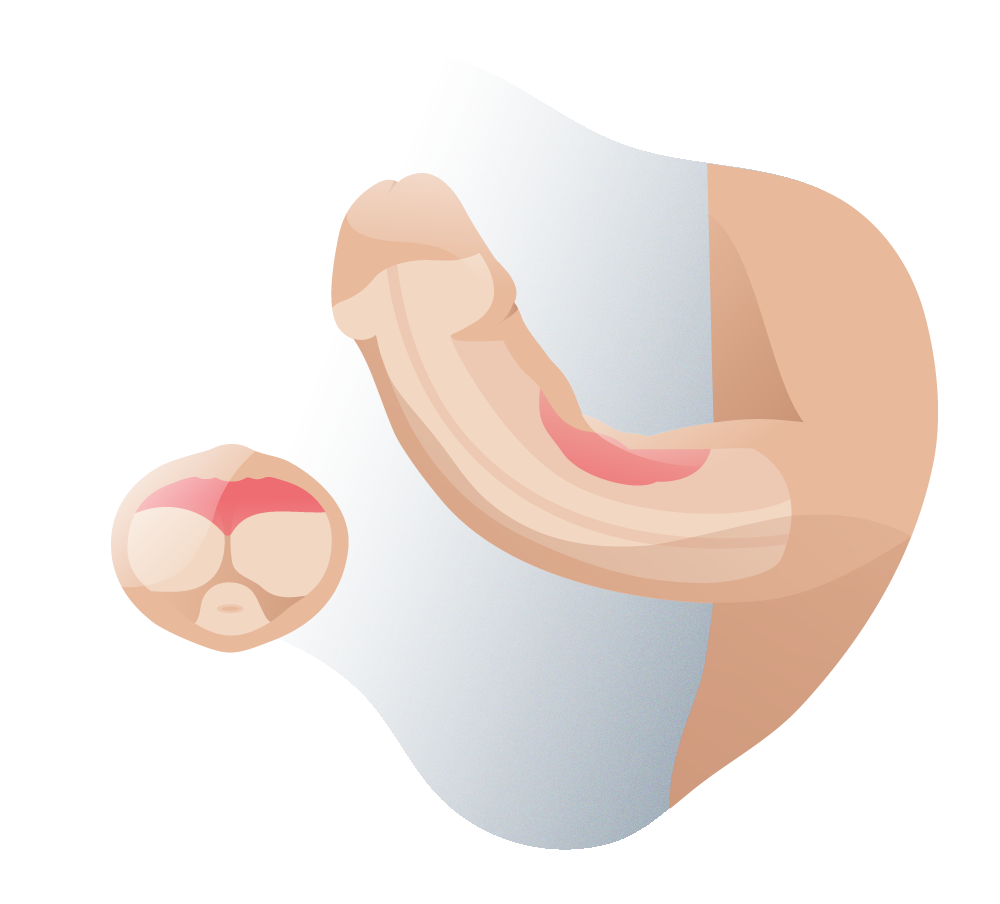
Fibrotic plaques in Peyronie’s disease
PEYRONIE'S DISEASE
Treatment Summary
This is short summary of the whole process: from the appointment request, to receiving the medical discharge after the treatment in some our Andromedi centers in Madrid, Seville or Canary islands (Tenerife)
Consultations Needed
We usually set two consultations as the minimum number, from which treatment is indicated. Each case is unique and needs to be evaluated very thoroughly.
Hospital Stay
For non-surgical treatments (collagenase, iontophoresis, etc.) the patient can go home the same day. With surgery the stay is 24-48 hours.
Anesthesia Type
In Peyronie's curvature correction surgery, local anesthesia is applied to the genital area and general sedation (for sleep).
Operation Time
It lasts from two to three hours, depending on the degree of affection and in the most extreme cases if a prosthesis is required.
Post-operative
It is important to take care of the wound, making sure it is clean with mild antiseptic solutions and avoiding sexual relations for a while afterwards.
Resuming Sex Life
The scar is usually minimal and sexual relations can begin after a month of Peyronie's curvature surgery.
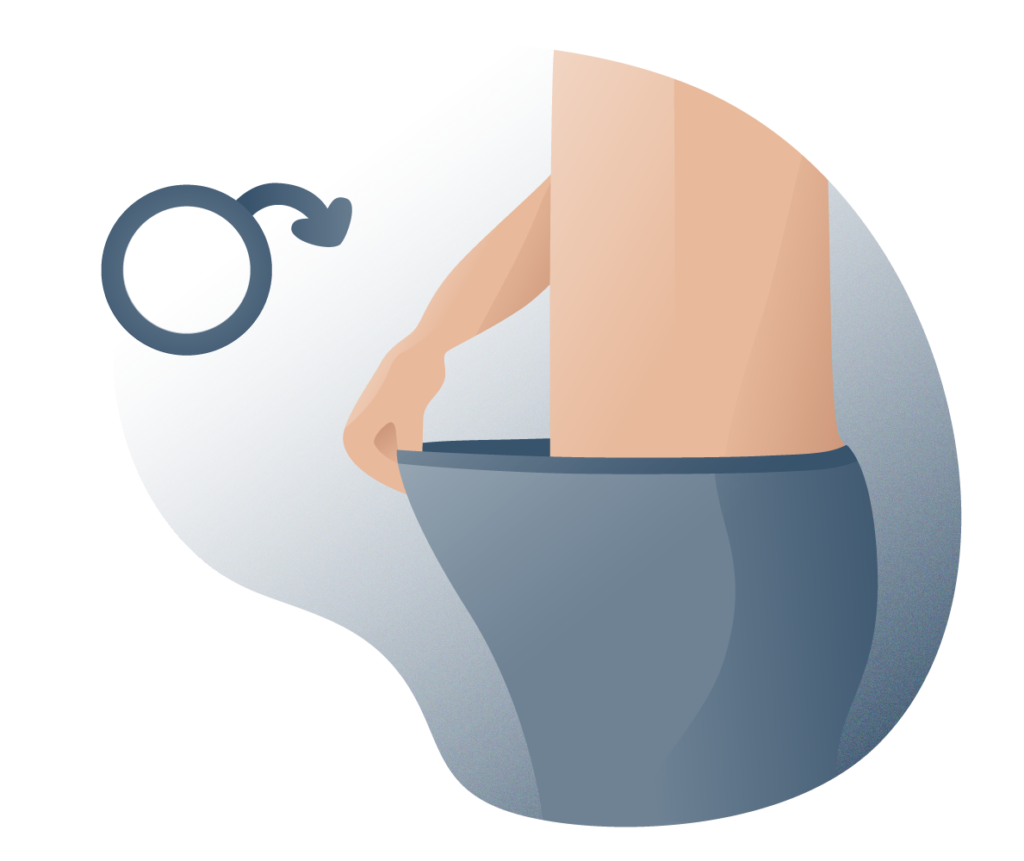
FREQUENT CAUSES
What causes Peyronie's disease or Peyronie's curvature?
Peyronie’s disease has its origin in a non-elastic fibrous scar that occurs in some portion of the tunica albuginea that surrounds the corpora cavernosa.
This fibrotic lesion can be palpable and in many cases, visible to the naked eye when the penis is erect. In addition to becoming curved, the penis can become smaller and cause pain during intercourse or masturbation.
Many of these fibrotic plaques have their origin in repeated micro-traumas during intercourse, which produce points of tissue healing and retraction of the spongy body.
Also, there are pathological shortenings in the length of the urethra (and therefore the spongy body) that cause ventral retractions and curvatures of the penis.
Info
In theory, the lesion affecting the albugineous layer of the corpora cavernosa in Peyronie's disease should not directly affect the physiological mechanisms responsible for maintaining an erection.
However, when the curvature of the penis is very large, erectile function can be affected due to discomfort and pain during penetration, or even irreparable tissue damage in the worst case. Many men have diminished sexual abilities after developing Peyronie's disease.
MEDICAL EVALUATION
How is the disease diagnosed? How do I know for sure if I have Peyronie's?
This male erection disorder almost always occurs in men between the ages of 40 and 60 who have suffered some degree of minor penile incurvation during their lives.
The development of the plaque or fibrotic nodule is accelerated and when the patient begins to see problems, is when they seek medical help.
In the medical consultation with the urology or andrology specialist, the patient undergoes a series of procedures to understand the evolution of the signs and the degree of sexual dysfunction.
These procedures include:
- to understand the patient's health history, degree of incurvation, sexual habits and problems that he may be suffering because of penile curvature.
- To visualize the curvature and locate by palpation the point of fibrotic tissue that is causing the penis to deviate to one side during erection.
Taken by the patient himself, especially during erection.
How do I know if I have Peyronie?
But, many men can suffer from some curvature of the penis without necessarily being a case of Peyronie’s disease. Because of this, there is a medical criteria to determine when a penile curvature is pathological and when it is not: the angle of the penile curve.
It is considered a pathological penile curvature when the organ has an angle of incurvation equal to or greater than 30 degrees. Less than that, it rarely causes discomfort during sex or masturbation and therefore no treatment is necessary.
"...In our medical criteria, we see the iontophoresis and surgery tandem much more beneficial, that is why we do not offer it often for this ailment..."
Symptomatology
What signs and symptoms can Peyronie's disease have?
The main clinical manifestations of Peyronie’s disease are three:
Deformity of the penis
Due to curvature of the penis. It is often towards the abdomen, called dorsal curvature or towards some side, called lateral curvature.
Pain
This is the most common symptom of the disease, but it is rarely serious and even more so when the penis is not erect.
Fibrotic plaque
On the penis that can vary in consistency from a soft nodule in the early stages to a calcified hard spot when the disease is in its final stages. In some cases it may be imperceptible, even if the curve is generated.
Also, Peyronie’s disease can produce or trigger the appearance of other symptoms, the most important of which is erectile dysfunction.
Erectile Dysfunction
Erectile dysfunction or ED can be due to several elements, such as deformity of the penis that prevents and hinders intercourse, the emotional consequences of seeing diminished sexual capacities, and pain during penetration.
Disfunción eréctil
La disfunción eréctil o DE puede deberse a varios elementos como la deformidad del pene que impide y dificulta el coito, las consecuencias emocionales de ver las capacidades sexuales disminuidas y el dolor durante la penetración.
In some cases, fibrotic plaque can compress the blood supply to the underlying cavernous tissue and cause the erection to be ineffective.
Looking for prices and information?
Use our virtual assistant and receive in your email everything related to the treatments that interest you. Budgets, recovery times, hospitalization, financing possibilities month by month, etc.
In just a few minutes and without any commitment.
En cumplimiento del Reglamento General de Protección de Datos le informamos que los datos por Vd. proporcionados serán objeto de tratamiento por parte de Andromedi con la finalidad de prestarle el servicio solicitado y/o contratado. Los datos no se cederán a terceros salvo en los casos en que exista una obligación legal. Para más información puede consultarla pinchando aquí.

solution
Is it possible to correct penile curvature? How to eliminate Peyronie's disease?
Peyronie’s disease is a medical diagnosis that has a solution as long as it is treated quickly and appropriately. Most treatments can reverse the fibrotic process and allow the patient to enjoy sexual function again without any sequelae.
It is possible to eliminate the curvature of the penis!
The development of different and innovative treatments and their application according to each particular case ensures that Peyronie’s disease is a non-definitive disorder in patients.
These treatments range from conservative medical management with drugs to fairly safe surgical techniques that manage to completely remove the point of damaged tissue and regain the normal shape of the penis.
OPINION
Real testimonies from our patients
Andrés
Paciente de Curvatura de Pene
TECHNIQUES AND TREATMENTS
Non-surgical treatments
Most existing non-surgical treatments are considered conservative therapies (with little or no corrective effect) because they do not directly manipulate the lesion of the tunica albuginea of the penis where the incurvation is taking place.
These treatments consist of the administration of drugs designed to stop and reverse the healing process of the corpora cavernosa. They are indicated in the early stages of the disease (acute phase) when there is marked pain and progressive deformity.
Among the drugs that have been used to treat Peyronie’s disease, the most important is collagenase.
Local infiltration of collagenases such as Xiapex® or Xiaflex®
Collagenase is a synthetic enzyme obtained by bacterial synthesis in a pharmaceutical laboratory, often produced by a bacterium called Clostridium Histolyticum.
This enzyme has the ability to break down collagen fibres accumulated in the fibrotic plaques of Peyronie’s disease when injected directly at the site of injury through a special syringe.
This drug has been used in recent years in the treatment of Peyronie’s disease and other diseases with an accumulation of tissues with high content of collagen fibres in different parts of the body, with results that may vary from patient to patient, such as Dupuytren’s disease.
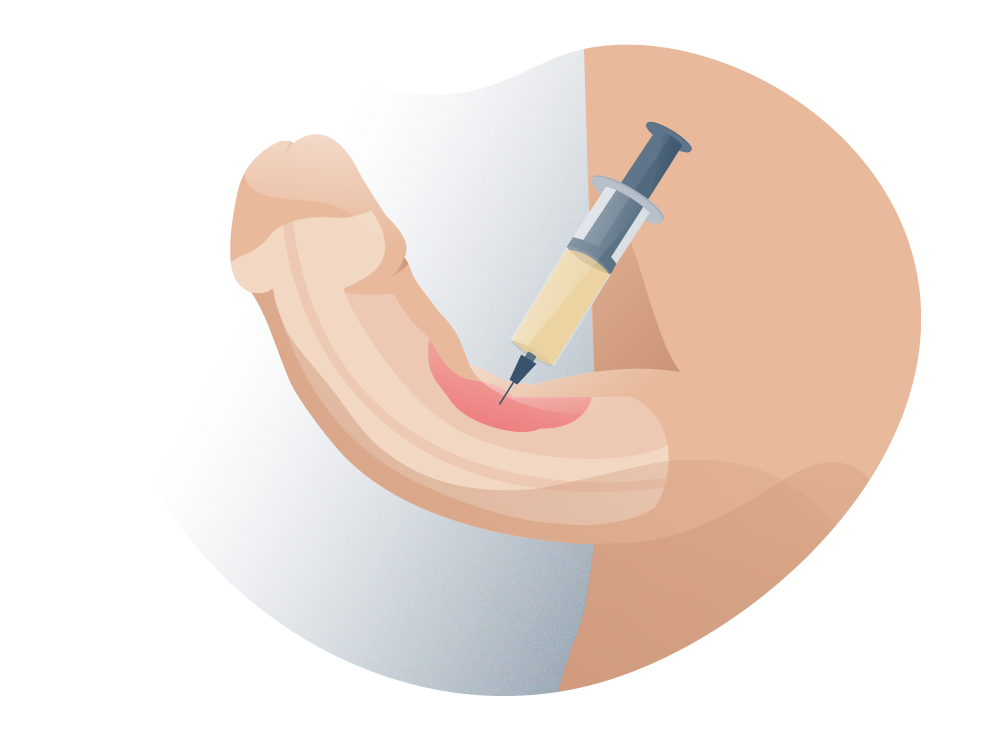
Peyronie non-surgical treatment
However, there is bad news for patients receiving collagenase treatments. For commercial (not safety or administrative) reasons, drugs marketed in Europe as Xiapex® or Xiaflex® will no longer be served, leaving only the existing batches in circulation.
After this date, drugs will no longer be available and other corrective therapy, such as surgery, will be necessary.
Iontophoresis
Considering that Peyronie’s curvature is caused by the formation of small nodules of hard tissue in the corpora cavernosa that deform the penis during erection and produce pain and discomfort, it is crucial that treatments be carried out that seek to reverse the fibrotic process by stimulating the repair of the cells that compose it.
Among these treatments that promote tissue renewal is iontophoresis.
Iontophoresis is a technique that consists of administering a medication on the skin of the penis with the placement of a small pad that induces electrical current, so the absorption of this drug which reduces the fibrous scar is much more accelerated and optimal.
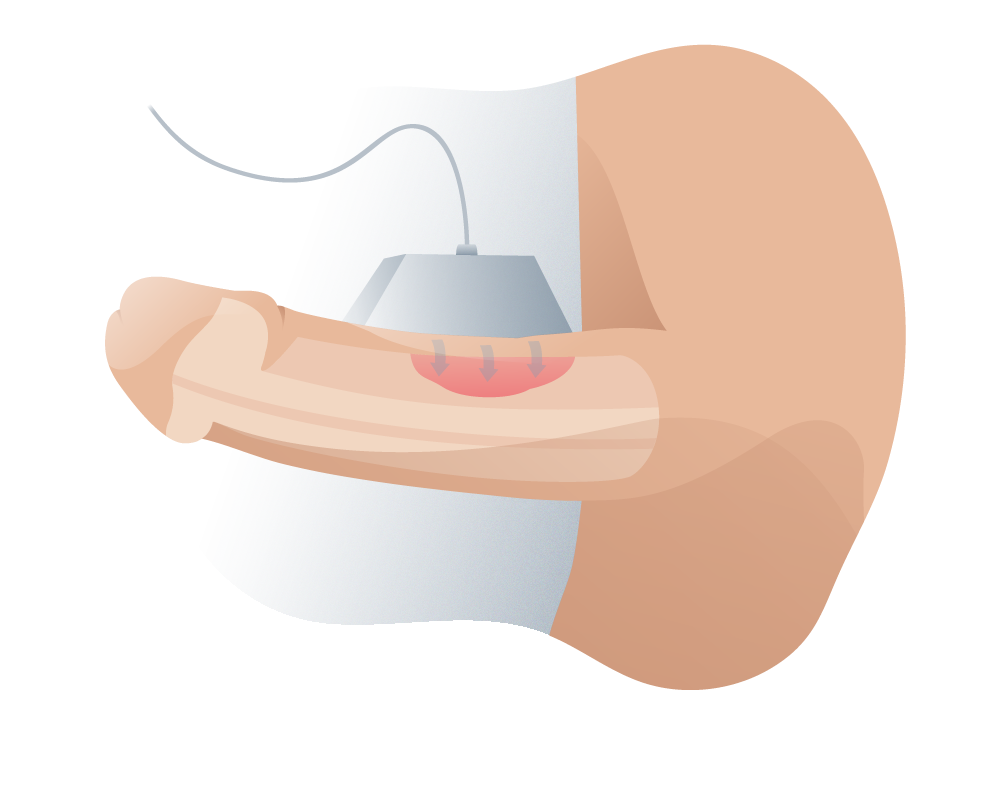
Iontophoresis for Peyronie’s disease
To create an electrical polarity it is necessary to place another electrode on the skin around the penis, usually on the skin of the thigh. This creates a current flow through the tissues and enhances the effect of the drug.
This technique has proven to be quite safe and effective in treating Peyronie’s disease, especially when implemented in the early stages of the disease.
It is estimated that within the first two to three months of beginning treatment, it is possible to see satisfactory results, stopping the progression of the disease (stabilizing it) and preparing
What role do vitamin E supplements play in treating penile curvature?
Vitamin E, popular for its regenerative properties in tissues, has been a great ally in stabilizing fibrotic plaques in many parts in the body. In the penis with Peyronie’s disease, vitamin E may promote tissue renewal and be a complement to other types of therapy.
Its effectiveness has not been directly proven, although empirically it has and widely, and it is intuited that it can serve as a promoter of tissue repair.
Techniques and treatments
Surgical treatment
Pre-operative
The preoperative period for Peyronie’s disease includes the period in which we perform the necessary tests to understand the type of surgical technique to be used (tunica albuginea plication or excision and tissue grafting) depending on the degree, shape and disposition of the incurvation.
Traditionally, penile curvature of less than 60 degrees that does not present “hourglass” thinning is a candidate for surgery with phalloplasty or plication of the tunica albuginea. If, on the other hand, it is bigger than 60 degrees of inclination or less than 60 but presents an “hourglass” effect, excision and tissue grafting have been indicated as a general rule.
But as we say, that is what has been traditionally done. In our practice in Madrid, Seville and Canary Island, we understand that the size of the penis is something very important (a growing concern) for men today, which is why more than 80% of the interventions we have been performing for several years now include tissue grafting in order not to lose length.
In the preoperative period, the patient’s personal history is also investigated, such as the diseases he has suffered from (especially disorders of the body’s cartilaginous tissues such as Ledderhose disease, Garrod’s nodules on the fingers or nodules in the auricle).
Pre-anaesthetic tests are also performed to ensure that there will be no adverse reactions to these drugs during the intervention.
The patient should follow a set of guidelines prior to surgery such as:
- To notify if he has clotting problems or chronic diseases (cancer, diabetes, high blood pressure) or has suffered acute or chronic infections in the previous days.
- Do not consume alcohol or smoke tobacco.
- Do not take anticoagulant drugs or glucocorticoids.
- Maintain a fast 12 hours prior to the intervention (empty stomach).
- Go to the hospital with a companion in order not to have to drive under anaesthesia when returning home.
Intervention
Once in the operating room, the patient receives local anaesthesia in the genital area and some general sedation to keep him calm during surgery, but not completely unconscious. Corresponding antisepsis of the penis, scrotum, and adjacent structures is performed to decrease the risk of infection.
The surgical techniques or approaches surgeons use to treat Peyronie’s disease are:
Plicature of the tunica albuginea
It is the most used technique in other medical centres. It consists of bringing the penis into a state of induced erection with the injection of physiological solution into the corpora cavernosa. This will allow better visualization of the curvature and operate easier than being flaccid.
The surgeon then proceeds to trim some tissue opposite the site of the curvature by removing a portion of the contralateral corpus cavernosum or with plication (small sutures) from the contralateral tunica albuginea. This will make the lengths of both corpus cavernosum equal and the curvature no longer noticeable.
The disadvantages of this technique are the more than likely shortening of the length of the erect penis and the impossibility of being performed in severe cases of Peyronie’s curves.
The advantages range from the fact that it is the most “safe” technique (with the less clinical risk of errors) practised, to the fact that it has a short recovery time with a low risk of complications
"...In our medical criteria, we see the iontophoresis and surgery tandem much more beneficial, that is why we do not offer it often for this ailment..."
· Tunica Albuginea excision and tissue graft ·
1 This is the technique we use the most at Andromedi. As with the previous technique, excision of the tunica albuginea requires the penis to be in an erect state, which is induced through intracavernous administration of physiological solution.
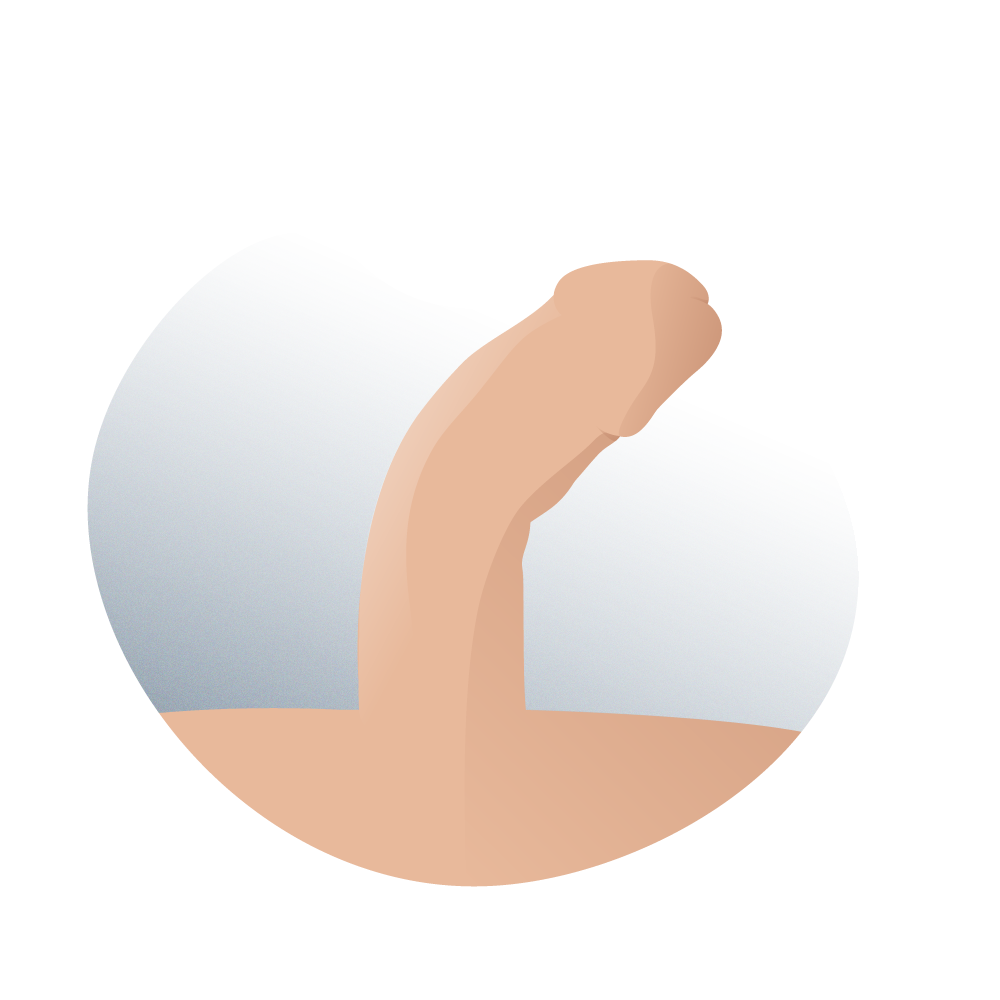
Peyronie surgical treatment (resection + correction) 01
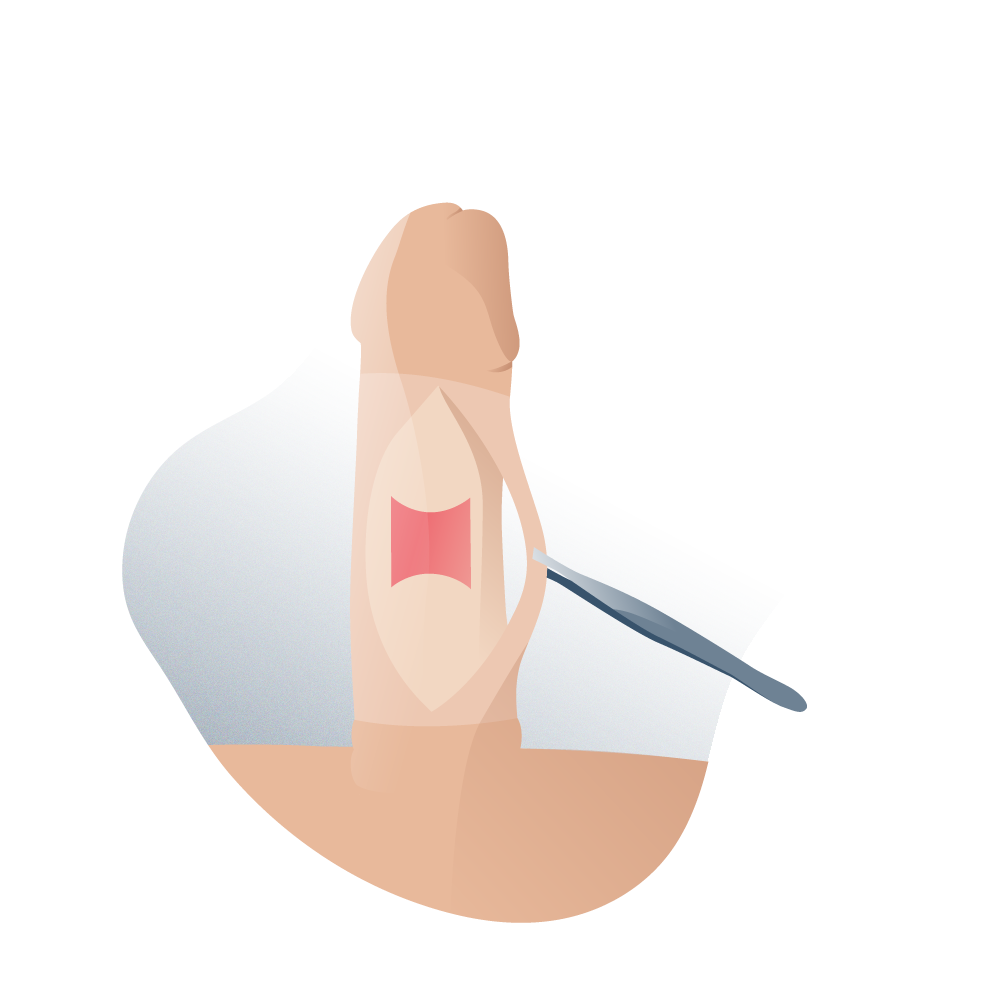
Peyronie surgical treatment (resection + correction) 02
2 When the penis is erect, Dr. Natalio Cruz, with more than 25 years of experience in Peyronie’s correction, proceeds to extract the point of fibrotic tissue and to fill that area with some tissue obtained from other locations in the body, to avoid future deformities or erectile dysfunctions.
3 A possible complication of this technique is that some retraction of the tissue can be developed over time and therefore some shortening of the penis occurs. However, this shortening is infrequent and, if it occurs, very slight.
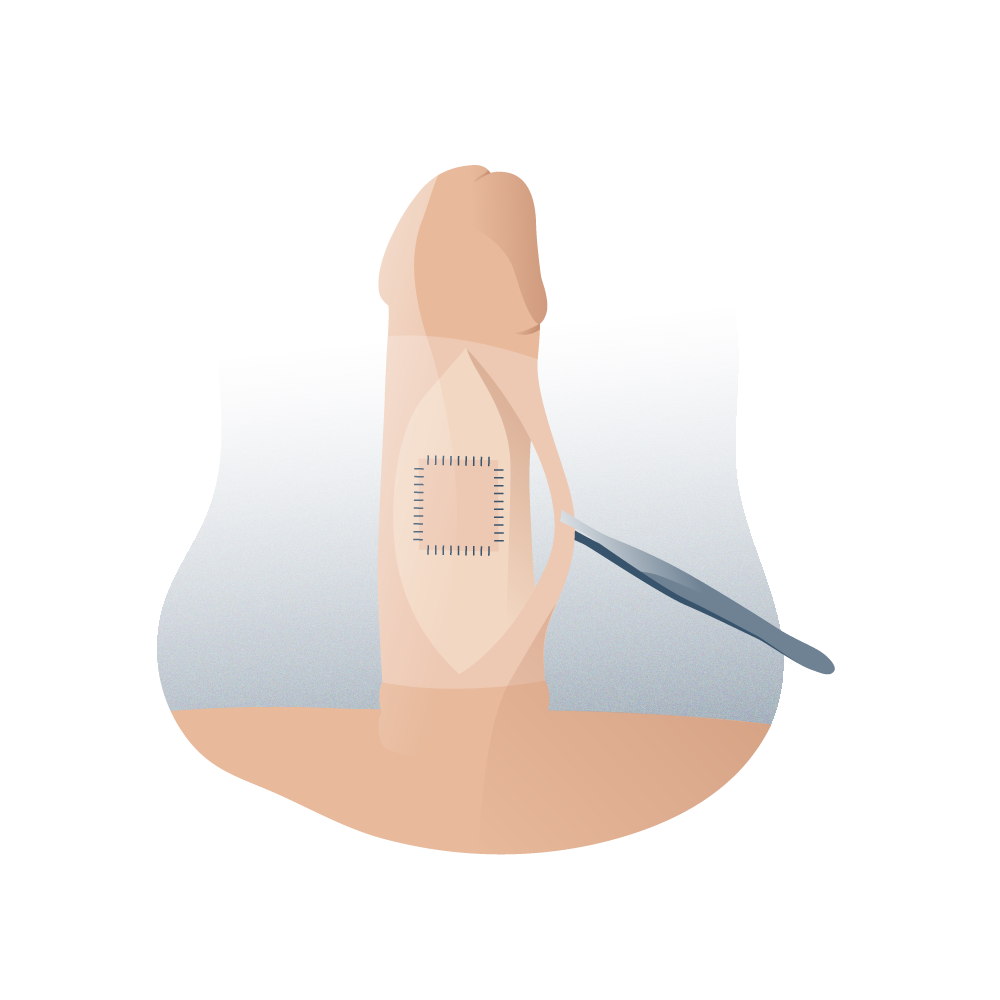
Peyronie surgical treatment (resection + correction) 03
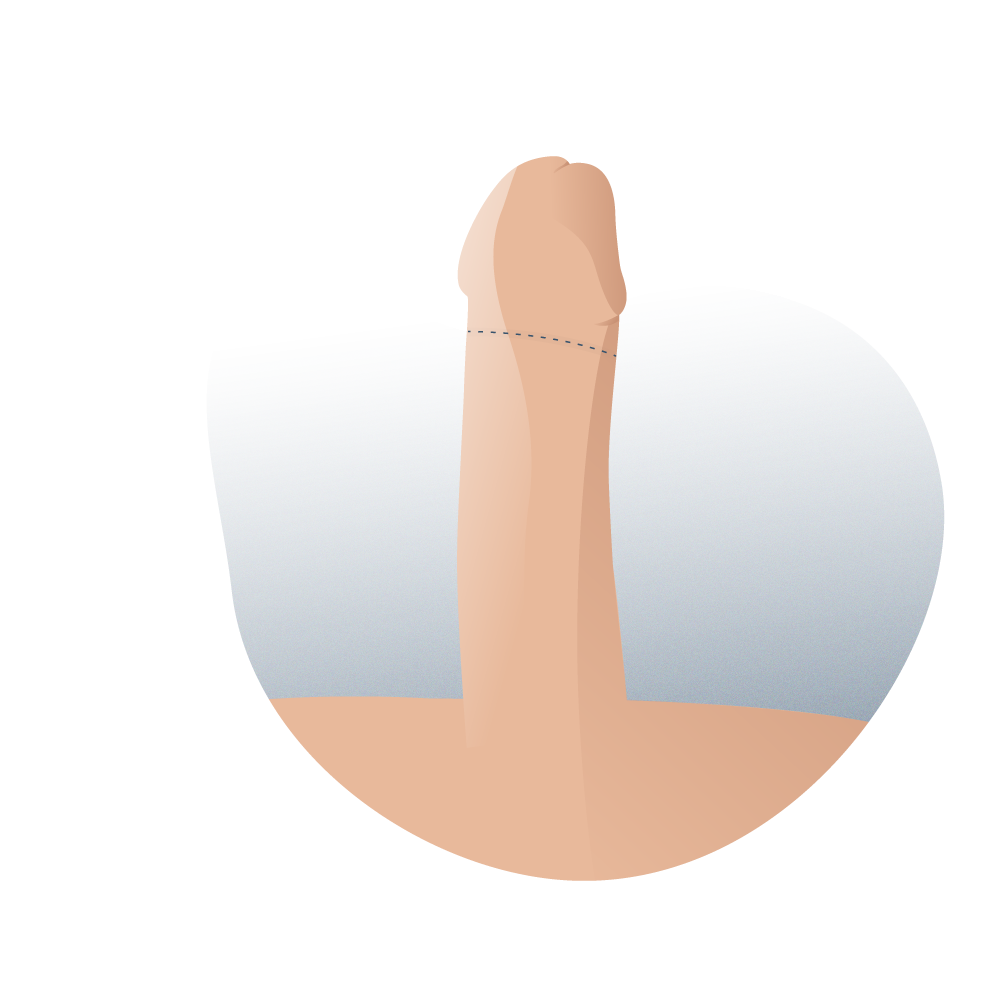
Peyronie surgical treatment (resection + correction) 04
4 A possible complication of this technique is that some retraction of the tissue can be developed over time and therefore some shortening of the penis occurs. However, this shortening is infrequent and, if it occurs, very slight.
The advantages, of course, are that the fibrous scar is completely removed and with it, the deformity, without shortening the limb.
· Tunica Albuginea excision and tissue graft ·
It is not by chance or for pleasure that we constantly emphasize the importance of going to the urologist/andrologist immediately when the first symptoms of incurvation are noticed. If not treated in time, the consequences of an uncontrolled case of Peyronie can be devastating, to the point of naturally preventing erection due to physical damage to the tissues.
In cases in which we foresee from the very beginning that after the curve correction intervention the erectile dysfunction will remain (which will probably already be present at the time of the first visit to the clinic), we already tell the patient about the possibility of needing a dual operation: correction + implant.
It is a long and complex dual intervention, which fortunately a low percentage of patients will need. We say fortunately because it is something which price is very high, especially because the prosthesis is a high-cost treatment. For this and other advanced surgical treatments, we have a line of financing to deal with this situation, with which we can pay the total amount in up to 48 months (4 years).
· Post-operative ·
Surgery to correct penile curvature usually takes between two and three hours. Upon leaving the operating room, the patient must remain in the hospital for 24 hours to fully recover from the effects of the anaesthesia.
Surgical wound care ranges from antisepsis of the skin with mild solutions to clean the skin, to changing the gauze that protects the site of the sutures (which are usually very small so there is no scar or it is barely visible).
What are the results I can expect once I have Peyronie’s Curve surgery on my penis?
The vast majority of patients who have undergone surgery to correct Peyronie’s curvature state that they have been able to significantly improve the physical appearance of their erect penises and thus also improve their sexual performance.
By achieving optimal shape during erection, patients with Peyronie’s disease can have sex with straight, rigid penises without the pain they felt before surgery.
Another type of surgical treatment: corporoplasty. How can corporoplasty help me treat Peyronie’s disease?
Corporoplasty is a type of surgery that is performed to correct deformities of the corpora cavernosa of the penis during an erection. This includes all other penile deformities not directly caused by Peyronie’s curvature with extraordinary results.
Pre-operative evaluation is key to determining the optimal size and shape the penis should have. If there is also a fibrotic process such as Peyronie’s, corporoplasty can help improve the patient’s condition and make their sex life better.
Techniques and treatments
Other non-surgical non-pharmacotherapeutic treatment
Are shock waves really an effective solution to this disease?
Studies by the Boston Medical Group, suggest that about 57 per cent of men with penile Peyronie’s curvature may find improvement with shockwave therapy.
However, the effectiveness of shock waves (revascularizing effect) is significantly greater when applied during the initial phases of the disease when the deformity is in full growth and pain is marked. The pain occurs because the deformity can compress certain nerves during erection.
In our medical criteria, we see much more beneficial the tandem iontophoresis and surgery, that is why we do not offer it often for this ailment. We understand that not all medical centres have the necessary operating room experience, and therefore offer substitutes such as shock waves, which help to a moderate degree, but not enough. We also understand that not everyone wants to go into the operating room and is looking for a non-surgical solution. In these last cases, we expose the pros, cons and expected results to the patient, leaving the decision to him.
".. In our medical criteria, we see the iontophoresis and surgery tandem much more beneficial, that is why we do not offer it often for this ailment.."
Novel surgical equipment
TACHOSIL®
In our clinics in Madrid, Seville and the Canary Islands, we have used TachoSil® patches for years for correction of acquired penile curvature (Peyronie’s corporoplasty) that allow reconstructions that just a decade ago were not even imaginable.
What is the TachoSil® patch? How does it work?
The TachoSil® patch is a new surgical material that consists of an adhesive matrix that, joining the exposed tissues of the body, promotes healing and repair of damage thanks to an amazing combination of two biologically active ingredients: fibrinogen and thrombin.
Fibrinogen and thrombin are substances produced by the body itself and activated during the clotting process to stop bleeding and serve as a “bridge” for new cells to repair damaged tissue.
TachoSil® is a non-toxic and friendly material with the body tissues that has been used with great success in different kinds of surgeries as a type of “graft”. In the field of urology, TachoSil® patches have been shown to be highly effective in the surgical repair of penile curvature due to La Peyronie’s disease.
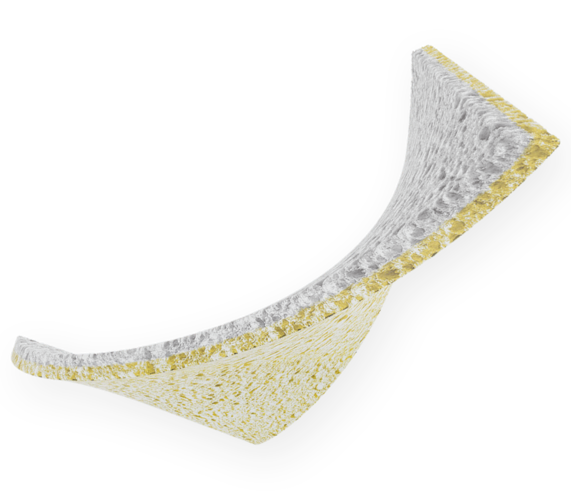
TachoSil® patch technology
Penis surgery with TachoSil®
This medical procedure is performed in those patients with moderate to severe curvatures greater than 30° that are uncomfortable and unsightly for patients. Importantly, this surgery does not shorten the length of the limb but rather straightens it or straightens it, which could actually make it look longer and stiffer.
After an accurate diagnosis and some preoperative consultations, an appointment in the operating room is prepared for penile surgery with the TachoSil® patch.
After placing local anesthesia plus some general sedation, the surgeon cuts around the foreskin to expose the corpora cavernosa of the limb and the points of curvature (or fibrosis of the tunica albuginea).
The surgeon then places a small but sufficient amount of TachoSil® Adhesive Matrix and closes the incision with stitches. The patient can return home that same day to continue with the recovery (which is usually faster compared to surgeries without TachoSil®).
Corporolplasty without limb shortening with TachoSil®
This occurs because the TachoSil® patch promotes an ideal matrix for the formation of new collagen fibers and cells thanks to the fibrinogen and thrombin that it is composed of. This improves the shape of the member while maintaining the length of the penis.
In traditional corporoplasty, it is necessary to remove the fibrous portion of the tunica albuginea from the affected corpus cavernosum (this technique is known as plication). Since it is an internal tissue, it has a slower turnover rate and usually the patient notices a slight to moderate decrease in the size of his penis due to the natural shrinkage of the tissue.
The latter is the common reason why many men prefer not to resort to penile curvature correction surgery. Fortunately, we surgeons have novel methods such as this cavernous TachoSil® patch application.
Frequently asked questions at the Andromedi centres in Madrid, Seville and Tenerife
Aunque las deformidades del pene son comunes rara vez son patológicas. No obstante, se calcula que entre el uno y tres por ciento de todos los hombres en edad reproductiva padecen de enfermedad de Peyronie.
Existen grupos de hombres con mayor predisposición a la enfermedad como los mayores de 70 años de edad (6,5 por ciento tiene curvatura de Peyronie) o los que padecen patologías prostáticas (8,4 por ciento).
Los estudios de prevalencia de enfermedad de Peyronie suelen ser difíciles de documentar dado la escasa información de interés clínico aportada por los relativamente pocos pacientes que buscan ayuda médica.
Los tratamientos homeopáticos para la enfermedad de Peyronie (como la calcárea fluorica, causticum, chelidonium compose y el tuberculinum) no están claros ni siquiera entre los propios homeópatas y además, no han sido documentados y evidenciados científicamente lo suficiente como para ser considerados eficaces y seguros. En nuestro criterio, los mejor es recurrir a un médico urólogo/andrólogo calificado ante cualquier deformidad o molestia en el pene.
Las populares bombas de vacío para el pene pueden resultar peligrosas si el paciente padece de enfermedad de Peyronie debido a que el aumento exagerado de volumen de sangre en los cuerpos cavernosos podría ocasionar dolor y favorecer que el proceso fibrótico avance y crezca.
Lo mejor es no utilizar este tipo de dispositivos si se padece de cualquier alteración morfológica del pene sin supervisión médica.
Las cremas o ungüentos con verapamilo pueden estimular la síntesis de enzimas como la colagenasa endógena (es decir, producida por el mismo organismo) en el sitio de aplicación.
Recordemos que la colagenasa es una enzima catalítica que destruye el exceso de fibras de colágeno. Al aplicar un fármaco de este tipo, se incrementa la síntesis de la enzima y se disminuye la cicatriz fibrosa que produce directa o indirectamente la curvatura del pene.
En Internet pueden encontrarse cientos de miles de técnicas caseras para tratar enfermedades como la de Peyronie con remedios en base a plantas y sustancias obtenidas de ellas.
No obstante, estos remedios no han sido comprobados científicamente en base a parámetros aceptados de seguridad y confianza, por lo que no es recomendable realizarlos. Las consecuencias podrían ser peores que el estado de la enfermedad actual.
Author
Natalio Cruz MD, with 25 years of medical experience, has been until 2016 Head of the Andrology Unit in the Urology Service of the Virgen del Rocío Hospital in Seville, National Coordinator of Andrology in the Spanish Association of Urology (AEU) and General Secretary in the ESSM, positions that he has narrowed to focus squarely on this exciting project of offering a high-level private medical consultation in Marbella, Seville, Madrid and Tenerife.
Andromedi pertenece a las organizciones médicas más destacadas en el sector de la Uro-Andrología